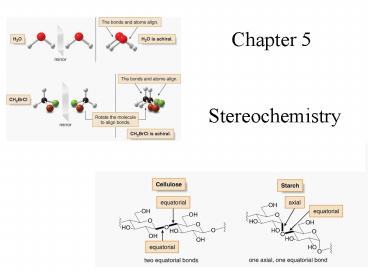Stereochemistry - PowerPoint PPT Presentation
1 / 34
Title:
Stereochemistry
Description:
Stereochemistry: Chiral vs Achiral Molecules. 5. Stereochemistry ... Chiral and Achiral Molecules. Four different groups. 7. Stereogenic Centers: Rings. 8 ... – PowerPoint PPT presentation
Number of Views:142
Avg rating:3.0/5.0
Title: Stereochemistry
1
Chapter 5
Stereochemistry
2
Stereochemistry Structure Function
3
Stereochemistry constitutional vs stereo isomers
4
Stereochemistry Chiral vs Achiral Molecules
5
Stereochemistry
Chiral and Achiral Molecules
- A and B are a type of stereoisomers called
enantiomers (non-superimposable mirror images of
each other) - A carbon atom with four different groups is a
tetrahedral stereogenic center (or
stereocenter).
6
Chiral and Achiral Molecules
Four different groups
7
Stereogenic Centers Rings
8
Labeling Stereogenic Centers with R or S
- Enantiomers are different compounds, so they need
to be distinguished using the prefix R or S to
the IUPAC name of the enantiomer. - Naming enantiomers with the prefixes R or S is
called the Cahn-Ingold-Prelog system. - To designate enantiomers as R or S, priorities
must be assigned to each group bonded to the
stereogenic center, in order of decreasing atomic
number. - The atom of highest atomic number gets the
highest priority (1).
9
Labeling Stereogenic Centers with R or S
- If two atoms on a stereogenic center are the
same, assign priority based on the atomic number
of the atoms bonded to these atoms. One atom of
higher atomic number determines the higher
priority.
10
Labeling Stereogenic Centers with R or S
- If two isotopes are bonded to the stereogenic
center, assign priorities in order of decreasing
mass number. (applications in nuclear medicine
and enzymology)
11
Labeling Stereogenic Centers with R or S
- To assign a priority to an atom that is part of a
multiple bond, treat a multiply bonded atom as an
equivalent number of singly bonded atoms. For
example, the C of a CO is considered to be
bonded to two O atoms.
12
Labeling Stereogenic Centers with R or S Example
13
Labeling Stereogenic Centers with R or S
14
Labeling Stereogenic Centers with R or S
15
Labeling Stereogenic Centers with R or S
16
Labeling Stereogenic Centers with R or S
17
Diastereomers Lets Practice !
- For a molecule with n stereogenic centers, the
maximum number of stereoisomers is 2n. Build all
possible stereoisomers of 2,3-dibromopentane.
- Stereoisomers that are not mirror images of one
another are called diastereomers. For example, A
and C are diastereomers.
18
Diastereomers
19
Meso Compounds
- A meso compound is an achiral compound that
contains tetrahedral stereogenic centers. C is a
meso compound.
20
Meso Compounds
- Compound C contains a plane of symmetry, and is
achiral. - Look for a plane of symmetry that produces two
identical halves.
- Because one stereoisomer of 2,3-dibromobutane is
superimposable on its mirror image, there are
only three stereoisomers, not four.
21
Meso Compounds
22
R and S Assignments in Compounds with Two or More
Stereogenic Centers.
One stereoisomer of 2,3-dibromopentane
The complete name is (2S,3R)-2,3-dibromopentane
23
Disubstituted Cycloalkanes
- 1,3-dibromocyclopentane has two stereogenic
centers, and has a maximum of four stereoisomers.
24
Disubstituted Cycloalkanes
- To find the other two stereoisomers (if they
exist), draw the mirror images of each compound
and determine whether the compound and its mirror
image are superimposable.
- The cis isomer is superimposable on its mirror
image, making the images identical. Thus, A is an
achiral meso compound.
25
Disubstituted Cycloalkanes
- The trans isomer is not superimposable on its
mirror image, so B and C are enantiomers.
- Because one stereoisomer of 1,3-dibromocyclopentan
e is superimposable on its mirror image, there
are only three stereoisomers, not four.
26
Stereochemistry
27
Stereochemistry
28
Physical Properties of StereoisomersOptical
Activity
- The physical properties of two enantiomers are
identical except in their interaction with chiral
substances. They differ in the way, they interact
with plane-polarized light.
- A compound that does not change the plane of
polarized light is optically inactive.
29
Physical Properties of StereoisomersOptical
Activity
- Dextrorotatory if the rotation is clockwise d
or (). - Levorotatory if the rotation is counterclockwise
l or (-). - Two enantiomers rotate plane-polarized light to
an equal extent but in opposite directions. - NOTE No relationship exists between R and S
prefixes and the () and (-) designations that
indicate optical rotation!
30
Racemic Mixtures
- An equal amount of two enantiomers is a racemic
mixture , and optically inactive. Impurity
entaniomers impact degree of rotation in a
non-equal mix.
31
Stereochemistry
Physical Properties of StereoisomersRacemic
Mixtures
- Specific rotation a standardized physical
constant for the amount that a chiral compound
rotates plane-polarized light at 250C, and
wavelength 589 nm.
32
Optical Purity
- Enantiomeric excess (optical purity) is a
measurement of how much one enantiomer is present
in excess of the racemic mixture. It is denoted
by the symbol ee.
ee of one enantiomer - of the other
enantiomer.
- Ex If a mixture contains 75 of one enantiomer
and 25 of the other, the enantiomeric excess is
75 - 25 50. Thus, there is a 50 excess of
one enantiomer over the racemic mixture. - The enantiomeric excess can be calculated if the
specific rotation ? of a mixture and the
specific rotation ? of a pure enantiomer are
known.
ee (? mixture/? pure enantiomer) x 100.
33
Physical Properties of Stereoisomers
- Enantiomers cannot be separated by common
physical techniques like distillation. - Diastereomers and constitutional isomers have
different physical properties, and can be
separated by common physical techniques.
34
Chemical Properties of Enantiomers
- Two enantiomers have the same chemical properties
except for their reaction with chiral non-racemic
reagents. - See also plants and ENZYME mechanisms

